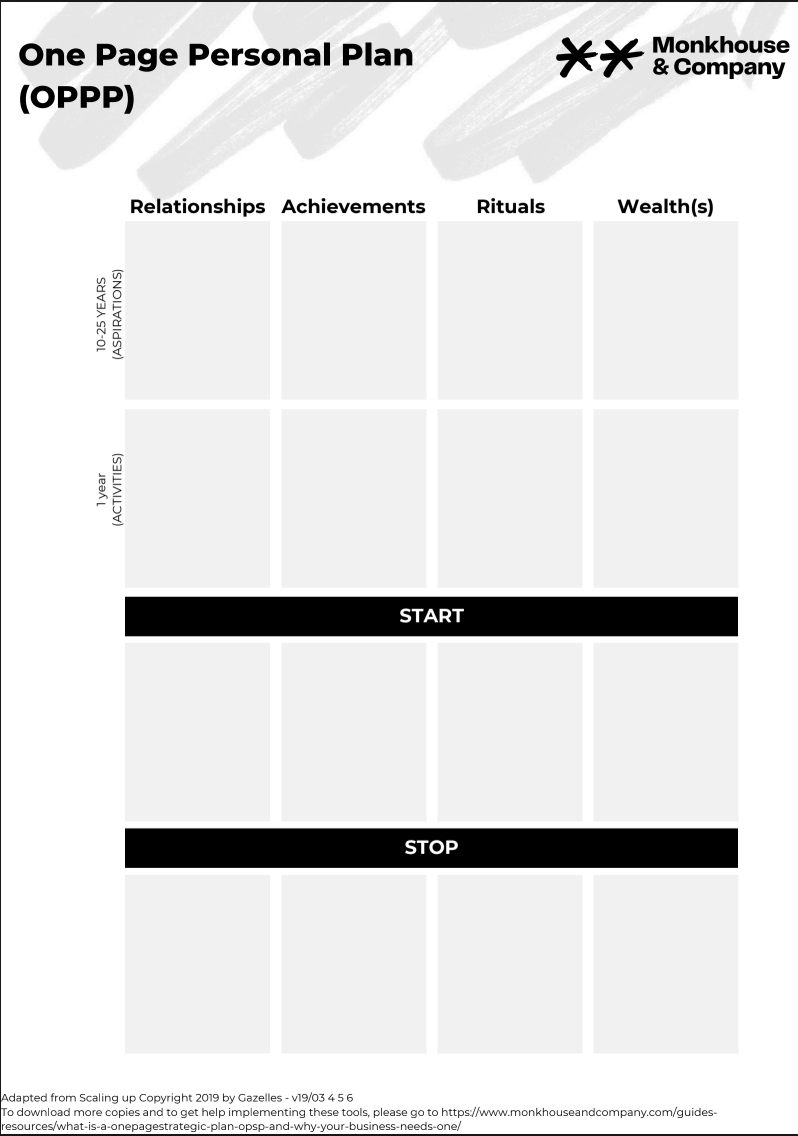Most leaders have a solid business plan — but no personal one. You can quote quarterly OKRs off the top of your head, yet if someone asks what you actually want from life in ten years, you’ll mutter something vague about “balance.”
We spend hours sweating over business strategy decks, but when it comes to our own lives, most of us are winging it. That’s where the One Page Personal Plan (OPPP) comes in — a brutally simple framework to bring the same focus and accountability to your personal life that you already apply to your business. If your company deserves a strategy, your life damn well does too.
The slightly morbid bit
Here’s a grim but surprisingly effective exercise. Picture your own funeral. You’re not in the box — you’re listening. What do you want people to say about you? What’s written on the tombstone?
It’s a weird thought, but it cuts straight through the fluff. Do you want to be remembered for scaling a business? For being the parent who showed up? For being kind? If legacy matters to you, that has to appear in your plan — because legacy doesn’t build itself.
Push it further. Imagine it’s ten years after you’ve gone. What’s still being said about you — or what’s stopped being said? Maybe nothing, and that’s fine too. But if you want to be remembered for something, you’d better start acting like that person now.
The good bit
Now, let’s switch gears. Forget death for a minute. Think back to a time when life was humming — when everything felt easy. You were in flow, things clicked, maybe you were fitter, laughing more, sleeping better. Who were you spending time with? What were you doing regularly that made it work?
That list — your “life works well when…” list — is gold dust. It’s your recipe for happiness, focus, and less stress. Most of us don’t need a new plan; we just need to stop ignoring what already works.
So before you grab the template, get honest about those two things: how you want to be remembered, and when life last felt bloody good. That’s the foundation for everything that follows.

Now we’ve done that it’s time to move on to the OPPP. At the top of the page, there is a space for the date. Pick a date that’s between 10 and 25 years in the future — maybe your birthday or an anniversary, something that matters to you.
What: the structure of the one page personal plan
Now that you’ve stared down your own funeral and remembered what makes life hum, let’s get practical. The OPPP turns that soul-searching into something you can actually work with — one page that captures what you want and how you’ll get there.
It breaks your life into four simple buckets:
- Relationships – the people who matter most.
- Achievements – the things that give you purpose and pride.
- Rituals – the habits and routines that keep you sane.
- Wealth – the freedom and resources to live life on your terms.
Each bucket spans three time horizons:
- 10–25 years (aspirations): your long-term vision, written in the present tense as if it’s already true.
- 1 year (activities): what must be true in 12 months to stay on track.
- 90 days (actions): the immediate stuff you can start or stop doing right now.
And because we humans are brilliant at kidding ourselves, each quarter you’ll choose just four things to start and four to stop — one per category. If everything’s a priority, nothing is.
Use the five Fs as a quick sense-check: Finance, Fitness, Friends, Family and Faith. (Faith doesn’t have to mean religion — it can just mean connection, meaning, or purpose.)
The goal is clarity, not poetry. Cameron Herold wanted his company to be a Harvard Business Review case study — he wrote it down and it happened. Jeff Hoffman wanted to visit 50 countries, so he built a travel company. Write it, make it specific, and you’ll find a way to make it real.
How: building your plan step by step
This isn’t some grand theory — it’s a process. You start big and pull it back until it feels real.
Step 1: the big picture (10–25 years)
Think of this as your life’s destination map. Where do you want to be? What does ‘great’ look like for you?
Here’s mine, for context:
- Relationships: As all 18 summers with my kids come to an end, I have a thriving relationship with my wife and four children. We’re close-knit, celebrating milestones and enjoying each other’s company.
- Achievements: I’m a recognised expert in scaling up businesses, having helped countless companies grow. I keynote at global conferences and have written several best-selling business books.
- Rituals: I keep a strong fitness routine — running, cycling, lifting weights and surfing five times a week. I make time to travel the world and stay energised.
- Wealth: I’ve achieved financial independence through diverse ventures that keep generating wealth and support philanthropic work I’m proud of.
It might sound lofty, but that’s the point. Write it like it’s already true — your brain loves a bit of delusion when it’s aiming for something good.
Step 2: bridging the gap (1 year)
Now pull that long-term vision down to earth. What has to be true one year from now for you to be on track?
My list this year looks like this:
- Relationships: Weekly family dinners, monthly outings, proper time with friends.
- Achievements: Launch my online CEO coaching programme and finish my next book on scaling past 100 employees.
- Rituals: Keep my four-times-a-week fitness routine and add a daily sauna and cold plunge.
- Wealth: Grow the firm by 50% without working harder — that’s balance, not burnout.
Be specific. ‘Spend more time with family’ is vague. ‘Sit down for dinner with them every Sunday’ is progress.

Step 3: making it real (90 days)
Here’s where it stops being a dream and starts being a to-do list.
Focus on the next 13 weeks. What tiny, deliberate actions can you take that’ll move you closer to that one-year vision?
Here’s my last 90-day sprint:
Start:
- Scheduling monthly family activities.
- Outlining the first draft of my new book.
- Doing press-ups and pull-ups — goal: 100/30 in 100 days.
- Booking CEO networking opportunities for next year.
Stop:
- Overcommitting to speaking gigs that distract from the business.
- Working late into the night.
- Delaying launches because I’m “too busy.”
- Doing admin tasks I should’ve delegated months ago.
Bite-sized goals are your best friend. Stephen Guise’s Mini Habits is bang on — start small enough that failure isn’t even an option. One push-up a day, one walk after dinner, one genuine “I’ll be home on time.” Doable builds momentum, and momentum builds change.
Step 4: reflection and reset
A plan is only as good as your follow-through. Every 90 days, stop, look back, and ask:
- Eulogy test: What do you want people to say about you when you’re gone — and are you living that way?
- Flow moments: When does life feel easy, fun, effortless?
- Highlights: What went brilliantly this past quarter? What do you want more of?
This isn’t about guilt-tripping yourself. It’s about course correction. You might need to nudge a goal out by a quarter — fine. You still know where you’re going. The point is to check in before you drift.
Then what: keeping it alive
The OPPP isn’t a one-and-done worksheet you fill in once and forget. It’s a living document — your personal compass.
Review it every 90 days. Refresh your one-year goals annually. Celebrate what’s working, and be ruthless about what’s not. Share your progress with someone who’ll actually hold you to it.
Dr Gail Matthews’ research found that people are 42% more likely to achieve their goals just by writing them down, and 70% more likely when they share updates with a friend. Accountability, commitment, and visible progress — it’s science, not woo-woo.
The One Page Personal Plan isn’t about perfection — it’s about direction. A small, deliberate course correction now beats drifting for another decade.
Your move
No more “I’ll get round to it someday.” That day is today.
Grab the OPPP template, pour yourself a strong coffee (or something stronger), and map out the life you actually want.
Written by business coach and leadership coaching expert Dominic Monkhouse. You can order your free copy of his book, Mind Your F**king Business here.

